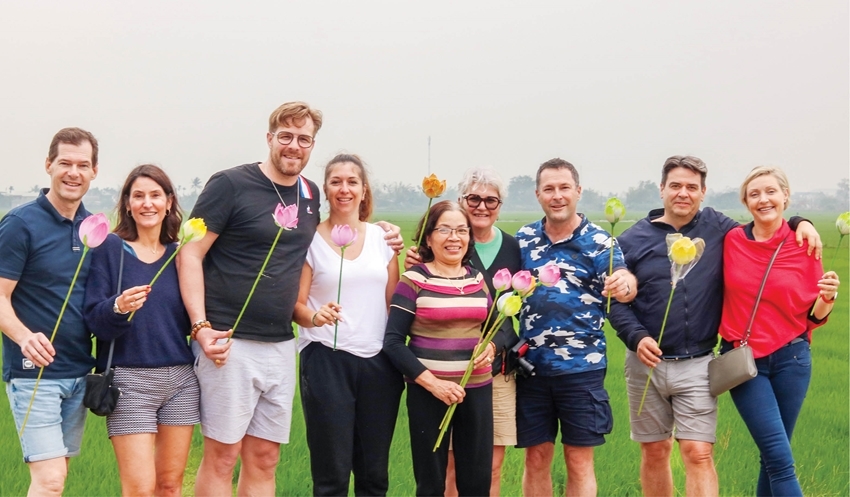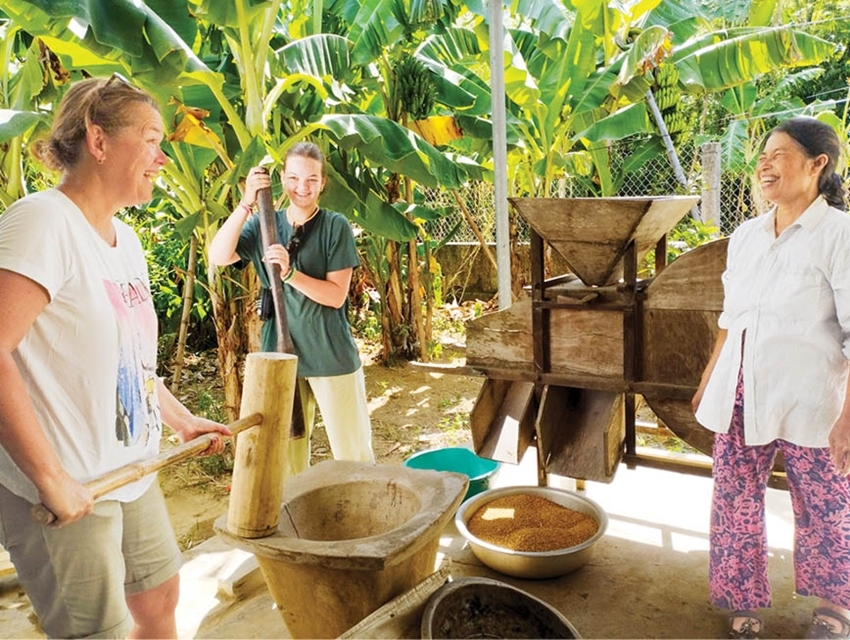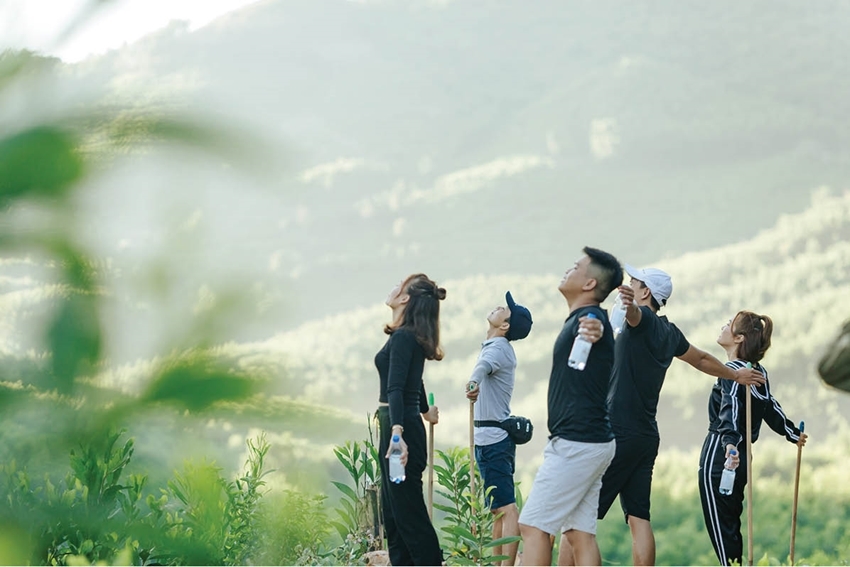Slow travel is emerging as a popular trend among many tourists. With its rich natural landscape, deep cultural and heritage roots, traditional way of life, and the unique warmth of its people, Hue holds many advantages for developing this form of tourism. However, to truly develop slow travel, Hue still has much work to do.

International tourists and Thanh Tien paper flowers. Photo: Slow Travel Hue
The right conditions are present
Following a group of foreign tourists on a trip to Thuy Bieu reveals how deliberately they immerse themselves in each activity along their journey. They do not rush through destinations just to “check-in”, but instead pause, listen, and engage with every local cultural feature. A German tourist remarked, “This is what travel enjoyment truly is. You let time slow down and allow yourself to fully feel the destination”.
A tour guide explained that this is what slow travel, also referred to as “leisurely travel” by some in the tourism industry. Since the COVID-19 pandemic, there has been a marked shift in travel preferences. Tourists have become more attuned to a slower pace of life, seeking to savor each moment and pursue more meaningful travel experiences. As a result, slow travel has emerged as a new travel method. According to Google Trends data, global searches for “slow travel” tripled those between 2019 and 2024.

Experiencing the culture of wet rice farming and rural life at Thanh Toan tiled-roof bridge. Photo: Slow Travel Hue
A proactive mindset is clearly reflected in slow travel. Tourists now value connection and the full experience of each moment, rather than hurriedly checking in at every destination. For their part, tourism professionals are increasingly building experiences around nature and local culture, placing the local community at the heart of creativity and hospitality. With many years of dedication to slow travel, Mr. Do Nguyen Phuong, Director of Human Culture Travel Co., Ltd., shared that slow travel can be developed in many places, and Hue is especially well-positioned to benefit from it.
Unlike traditional tourists confined to fixed tours and racing against the clock to “check in” at famous landmarks, these travelers prioritize authenticity. They seek lesser-known destinations and deeper connections. They choose to “go slow, feel deep”, opting to cook and dine with traditional Hue families, visit village markets, go for walks, cycle, row boats, explore craft villages, attend local festivals, or discover restaurants and food streets with strong local character, as well as artistic cafés with memorable stories. It is Hue’s tourism resources, unique culture, and characterful people that provide plenty of such experiences.

Experiencing Alba Wellness Valley by Fusion. Photo: Huu Phuc
In reality, slow travel is often associated with rural areas and small towns. Huế has a significant advantage with its ancient suburban villages just 5–7 km from the city center, such as Kim Long, Thuy Bieu, Thanh Tien, and Sinh Village. A green city that emphasizes sustainable tourism and peaceful living, Hue meets all the necessary conditions for slow travel to thrive.
According to Mr. Phuong, when Hue can effectively continue its storytelling, conveying emotional and authentic experiences, it will not only make the most of its existing potential but also turn its limitations into advantages. This will help attract high-quality travelers - those who travel not just to see, but to understand, to love, to rejuvenate, and to spread the values of the land of Hue.
Tackling challenges to develop
Head of the Planning and Tourism Development Division (Department of Tourism), Mr. Tran Minh Tan, believes that Hue has the advantage to create a distinctive offering. In some ways, slow travel stands as a signature product that contrasts with mass tourism and its busy, vibrant activities. This aligns well with the kind of leisure tourism many visitors now favor. Unfortunately, slow travel offerings in Hue remain limited.
Mr. Phuong noted that Hue has many strengths for developing slow travel and increasing tourist stay duration, but several challenges persist. The growth of slow travel remains below its potential, partly due to barriers such as connectivity infrastructure, ecological environment, and the active involvement of local communities in preserving and sharing culture.
For example, destinations such as Phuoc Tich Ancient Village or the fishing villages around Tam Giang - Cau Hai lagoon would benefit greatly from public transport services like buses connecting them to the city center or the Toa Kham boat wharf, making visits more convenient and affordable for tourists, encouraging them to explore ancient villages and living heritage sites while spending locally. Similarly, the ecological environment, a crucial part of the slow travel experience, is especially appreciated by tourists who value natural beauty and seek deep connections with nature. Even though Hue has made great strides with its “Green Sunday” campaign, in reality, some tourists, while in love with fishing villages and lagoon areas, have expressed concerns about waste pollution.
Mr. Phuong also emphasized that for slow travel to work, visitors need to stay longer, feel more comfortable, and engage more deeply with Hue’s natural and human life. To achieve this, it is necessary to address challenges not only in infrastructure but also in perception, overcoming outdated views tourists may hold of Hue, such as: “a rainy and gloomy place”, “harsh weather”, “nothing to do”, or assumptions that Hue is just about relics and “a half-day is enough”. “We don’t need too much”, he said, “but we do need carefully curated experiences that are consistently packaged and sustainable, so that travel agencies can confidently recommend them to visitors”.
Hue tourism must be more clearly positioned with core values tailored to the diverse needs of target markets, and communicated through compelling storytelling, multimedia visuals with professional, consistent, and creative outreach. In addition, there needs to be a stronger focus on safe and sustainable transportation links, especially the development of a bicycle-friendly route network from the inner city to suburban villages and local hamlets. This will not only enhance convenience for tourists but also reinforce Hue’s image as a “green - clean - bright” city that is environmentally friendly and welcoming.
Story and photos: Huu Phuc